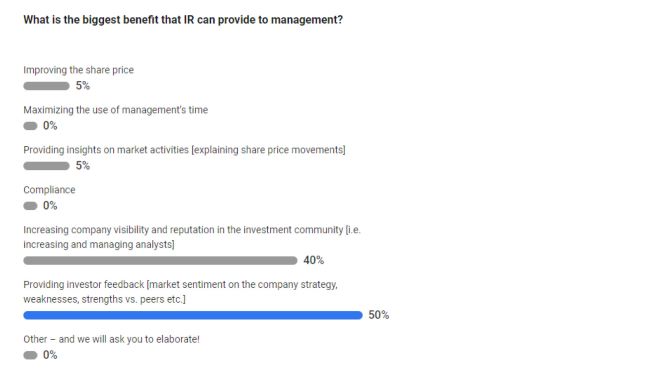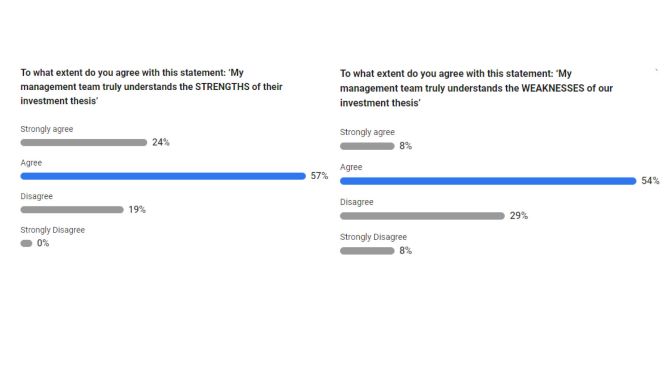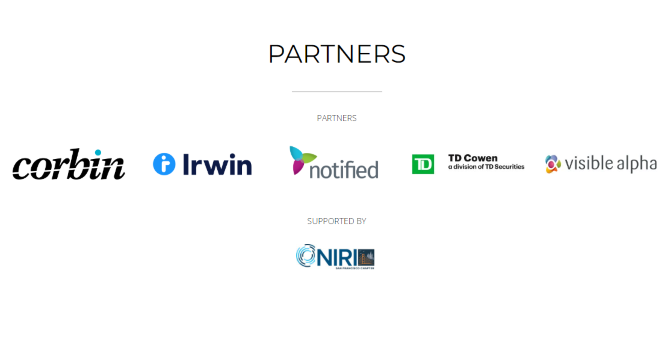At the recent IR Magazine Think Tank – West Coast in Palo Alto, California, IR professionals and members of the wider investment community delved into a range of topics that matter to industry players today.
Panel discussions and roundtables tackled topics such as aligning IR with management expectations in 2024, navigating sector-specific uncertainties, mastering the intricacies of earning calls, tailoring outreach to diverse investment styles, leveraging AI in IR practices and more. Below are 10 key takeaways from the event.
1. In 2024, IR’s main benefit to management is providing vital investor feedback
Attendees weighed in on the most significant value IR brings to management in the current economic environment, with a poll revealing a tight competition between IR offering investor feedback and enhancing company visibility within the investment community.
In fact, 50 percent of respondents picked relaying market sentiment on the company strategy, highlighting weaknesses and strengths versus peers as the top contribution made by IR to management. Increasing company visibility and fostering reputation in the investment community also emerged as a key benefit IR brings to the management table, with 40 percent picking it as their top benefit.

2. Refining investor messaging is a top IR priority this year
In 2024, IR priorities have adapted to address current challenges and opportunities. Conversations among industry peers at the think tank revealed an enhanced focus on delivering the company’s narrative to investors in a more refined and clear way. So how do you do that?
The first step is to fully understand your audience, experts said. From there, the advice is to leverage analysts for effective communications where possible, ensuring you are engaging with your retail investor audience – as it is a vocal community – and maintaining a clear investment thesis centered on both meeting key performance metrics and consistently delivering on milestones. These elements will bolster credibility amid market fluctuations.
Finding new investors also emerged as a top priority this year as more and more companies are exploring avenues beyond domestic markets and targeting international investors through strategic initiatives like roadshows and conferences.

3. Ensure management understands strengths and weaknesses of the investment thesis
Another poll survey at the event aimed at highlighting the extent to which management teams understand the weaknesses of their investment thesis. Results indicated a potential gap in awareness.
While most respondents (54 percent) agreed that management is aware of potential flaws, 29 percent of them disagreed with that statement. Acknowledging both strengths and vulnerabilities is especially essential in the face of heightened activism within the market, participants noted. IR professionals play a pivotal role in not only highlighting strengths but also identifying and addressing weaknesses effectively, speakers said.
‘Understanding weaknesses and offering solutions is where credibility is truly earned,’ said one attendee. ‘Whether that is at the table with your management team or on the road on your own, that is when you shine as a person and in your role as an IRO.’

4. Be consistent in your messaging when interacting with the sell side
Clarity and stability in communication with the investment community are essential. Whether facing a downturn, market stability or bullish trends, peers recommend remaining proactive and avoiding drastic shifts in approach. This will not only foster investor confidence but also reinforce the credibility of the company’s messaging over time.
5. Engage with analysts who have a bearish view of your company
IR teams are advised to actively engage with analysts, even those who hold bearish views about their company. Building relationships and maintaining transparent communication helps ensure the company’s equity story is properly conveyed to both sell-side analysts and investors. But it’s important for IR teams to discern between analysts who are receptive to dialogue and those who may not be, in order to allocate their time effectively.
‘If the analyst doesn’t pay attention to you, if he or she just writes maintenance notes after each earnings call but is not engaged, don’t waste your time,’ an attendee said. ‘If it is someone who you know has the respect of the Street and puts in the work, however, even if you have different views of the company, I wholeheartedly agree with the bear hug approach.’
6. If management needs more time to run the company, get creative
It is no secret that management time is rare and expensive. So if your management team needs more time running the business, how do you ensure you keep the investment community informed?
Think of creative communication strategies. Virtual events, such as webcasts and virtual conferences, offer viable alternatives to traditional in-person engagements, particularly when time for travel is limited. By leveraging these platforms effectively, companies can engage with investors and analysts while potentially reaching a broader audience. Furthermore, prioritizing quality interactions over quantity and targeting key stakeholders strategically are likely to enhance the impact of corporate access efforts.
7. Stay proactive in your investor-targeting efforts
Despite challenging macroeconomic climates, companies that remain proactive in their targeting outreach tend to perform better in the long term. Strategic targeting efforts, focused on quality over quantity, may yield higher returns. Furthermore, targeting strategies should evolve to align with shifts in company focus. ‘An approach that may have worked in 2020 or 2021 may not be the right one today,’ a speaker pointed out.
Echoing that, another speaker noted that continuous engagement with investors is essential regardless of the economic climate, as is tailoring the message to suit different investor preferences. ‘[This is crucial], especially in the post-Covid environment where virtual engagements have become more common and investor expectations have shifted,’ he said.
And when it comes to optimizing the use of management’s time it may be helpful to consider the type of event that works better for the company – balancing roadshows with conferences, for example. Companies are also encouraged to explore the effectiveness of virtual roadshows, where this is a viable option for them.
8. Build a data-driven approach to targeting
Leveraging unique datasets and ‘intent data’ can enhance the effectiveness of targeting strategies. Intent data includes any information that paints a picture of investors’ intent, such as website visitation numbers, earning calls participation data, news release viewership statistics and similar. And while this data may appear fragmented at first, by aggregating it companies can develop a nuanced understanding of investor preferences and tailor their outreach accordingly.
9. Balance your priorities
Balancing the needs of management, IR priorities, investor preferences and broker relationships is a juggling act that requires a clear top-down strategy. Companies should establish quantitative goals and metrics for investor engagement, revisiting over time to optimize resource allocation and maximize return on engagement efforts. Maintaining open communication with management and leveraging sell-side relationships can empower IR teams to take control of their outreach strategies.
10. Engage with retail investors
Engaging with retail investors poses unique challenges in the US, due to regulatory limitations and limited transparency. While access to retail investor data is restricted, a speaker suggested companies can leverage the non-objecting beneficial owner (NOBO) list to gather some data. NOBOs are beneficial owners of a company who give permission to a financial intermediary to release personal information to the companies in which they own stocks. ‘That is the only way we can get any kind of indication as to [who] the retail investors and non-reporting shareholders [in our company] are,’ the speaker noted.
Given their growing influence in recent years, fostering communication with retail shareholders and understanding their impact on governance and market dynamics is something companies should not overlook.











